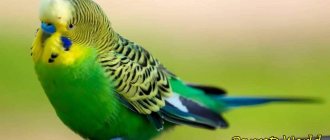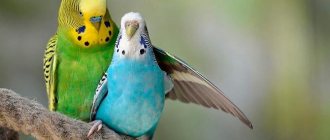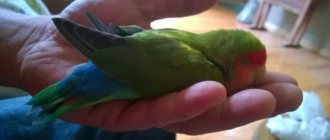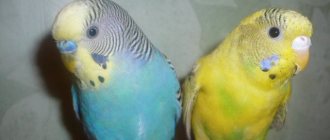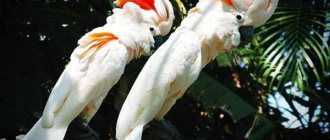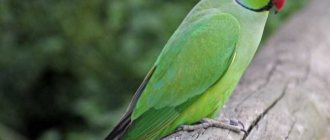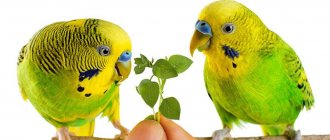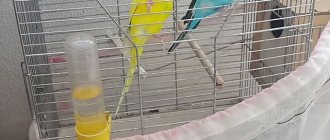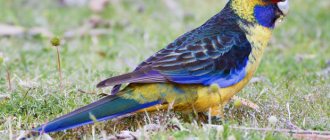Parrots are very interesting and mischievous creatures and watching them brings a lot of pleasure, lifts the mood and makes anyone happy.
Often, some of the habits of our feathered friends lead to bewilderment and there is a desire to understand the reason for such movements, poses and strange sounds.
By carefully studying your bird, you can come to the conclusion that the behavior of parrots is determined by certain factors: biological (puberty, instincts) and external (lifestyle, nutrition and living conditions of the bird).
Budgerigars have a changeable mood: they were just having fun and screaming, and now they are sitting ruffled and grumbling.
Photo: garden beth
It is very important to understand when a bird’s behavior is normal and when to be alarmed.
In the first days at home, tame budgies quickly get comfortable and begin to energetically explore everything with interest.
If you come across a wild parrot, then the bird will sit in one place in fear and watch in tension what is happening outside the cage.
Behavioral characteristics of birds
Wavy animals have a labile nervous system. They are characterized by rapid mood swings. They jump briskly around the cage, call each other loudly, and a minute later they can “scowl”, sit with a ruffled face and grumble from the corner. But this goes away, you just have to invite them to play, eat something tasty, or just chat.
In general, the behavior pattern depends on biological factors (maturation, reproduction, molting, incubation of chicks) and external conditions (care from the owner, communication with the pet).
Features of keeping at home
Budgerigars, like any member of a large family, need personal housing and free space. Why? The answer is very simple! Such birds love freedom and cannot stand being in one place for a long time.
Regular flapping of the wings is also necessary so that the limbs can develop and function normally. This is why it is so important to give your pet the opportunity to enjoy his own freedom for at least a few minutes.
What to do if your parrot doesn't want to fly
Domestic parrots live in cages. They are chosen depending on how wide the bird's wingspan is. It is better to avoid buying a round or oval cage. It is better to opt for a square or rectangular house.
It is necessary to consider how the floor covering in the cage is made. If grates are located there, this can become a dangerous option for the bird. It will be uncomfortable for her to move on such a surface. In doing so, she may injure her paws.
Numerous reviews suggest that it is better to purchase a cage with an automatically closing door. After all, very often birds can open it with their claws. Also, the owners themselves may often forget to close it. Similar incidents have been captured on video.
Why do you need to clean your cage regularly? A similar procedure is carried out to ensure that the bird does not get sick or become infected with various microbes. It is necessary to clean your parrot's home at least once a week.
Examples of cages for budgies are very easy to find in the photo. It is also useful to read reviews on forums and groups on social networks.
These birds can be fed with special food. It is also recommended to put sprigs of dill, parsley, and pieces of soft bread in the feeder. The parrot will not refuse fruit either. For budgerigars, the presence of light is important. It is also necessary to protect them from drafts.
Interesting facts about budgerigars can be learned from a large number of sources. Most often, it is best for inexperienced poultry farmers to watch a special video. You can find all the necessary information there. Finding forums and reading reviews will also be useful.
How do they behave in the wild?
In their native element, budgies are gregarious creatures, cheerful and active. Upon reaching puberty, they find mates and settle in hollows or rock crevices, trying not to move too far away from their relatives.
Habits of a budgie in the wild
Description, appearance
Budgerigars are a small species of parrot. Their length does not exceed 17-20 cm, with the tail accounting for 8-10 cm and the wing also 10 cm. Due to the long stepped tail, the birds appear larger than they actually are. The weight of parrots does not exceed 40-45 grams.
What does a budgie look like? Its natural color is grassy green. The feathers on the head (“face”) and throat are yellow. On the sides of the head there are elongated spots of blue color, sometimes with a purple tint. Several black spots are noticeable on the throat, by which many novice owners mistakenly determine the age.
On the back of the head and throughout the body there are peculiar black waves, which is why parrots got their name - wavy. If these waves begin from the forehead, then this means a young chick is in front of you. It is by these signs, also by the type of cere, that one can determine the age of a budgerigar.
By the way, the color of the wax always makes it possible to determine not only the age of the bird, but also the gender:
- the young male has a pinkish-purple cere, the young female is blue or light purple with white rims around the nostrils;
- an adult male has a bright blue cere; an adult female, as she grows up, acquires a white cere with a pink or blue tint; it becomes brown during puberty.
There are other ways to determine the age of these birds, you can read about them in the article: “Useful tips on how to find out the age of budgerigars.”
Budgerigars have an amazing feature: they are able to see ultraviolet light. Thanks to this, females accurately identify males when they see a “cap” on their head that emits a fluorescent glow. The brighter this glow, the more attractive the boy is to the girl.
Now about 200 color varieties of budgerigars have already been bred, which instead of green plumage can have blue, indigo, and violet. There are pure white wavy stripes without characteristic waves on the body, and there are also yellow ones.
These birds have strong curved beaks, which they often use as a third leg:
- grab objects with them and move them to the right place;
- cling to twigs and branches to move;
- they split seeds and small fruits, and also gnaw branches and crush foliage;
- with its help they defend themselves from enemies.
If you look closely, inside the beak of a budgerigar you can see small teeth (a kind of stratum corneum), which, like files, sharpen the beak, help to chew fruits and remove the husks from seeds and grains.
The legs of the wavy birds are blue-gray or pinkish in color with black claws. On each paw, two toes point forward and two point back. Thanks to this feature, parrots deftly cling to branches or cage bars and climb them, grab objects, even food and hold it in front of them.
False alarms - the bird refuses water and food
Firstly, birds in a new place are slightly stressed and this affects their appetite.
Secondly, they drink very little and do not eat much.
Thirdly, they know how to do all this secretly from the person, so you simply do not notice how the pet furtively visits the feeder and water bowl.
Budgerigar body language // behavior // Toffee and Kesha
You should not expect that the parrot will, figuratively speaking, rush into your arms on the very first day. He should get used to you. And if he loves you, then unconditionally.
Features of the behavior of a budgerigar
The behavioral characteristics of a budgerigar can always tell its breeder how the bird is feeling at the moment. The parrot, despite its constant cheerfulness, is a living creature. Something may be bothering him: a health condition or negative emotions. A caring owner should clearly know the habits of a budgie. When a pet's behavior goes beyond its usual habits, it is possible to quickly take action and keep the parrot healthy.
What behavioral features of a budgerigar are worth paying attention to and what does this mean:
- The parrot keeps his wings spread - most likely he is stuffy and hot
- The parrot sharply gnaws at the bars of the cage, as if attacking them - the pet is very unhappy with something
— The bird quietly rubs its open beak against the bars - this is most likely the usual cleaning of its beak
— The parrot is looking at you with its beak wide open. At the same time, his feathers on his head rise, and his neck stretches - a sign that you are very irritating him at the moment. Leave your feathered pet alone for a while.
- If a parrot ruffles its feathers and draws its head in, but does not fall asleep, but simply sits without moving, this is a bad sign. Most likely the bird is sick. It is advisable to show her to the doctor as soon as possible.
- When a parrot's chirping begins to develop into a scream, or even a squeal, this is an alarming signal. Try to carefully examine your feathered friend. He may have injured himself and is in severe pain.
Remember that your attentiveness and care towards your beloved bird is the key to a happy and healthy life for your budgie.
What influences a bird's behavior?
The first factor is health status. A sick parrot behaves unnaturally: it is either too active, nervous and irritable, screams loudly and rushes around the cage, or is lethargic and indifferent. The second is improper care. Little light, foreign odors, not enough space for normal well-being, poor nutrition - all this affects behavior.
Conditions of detention
If your budgie is not provided with the proper temperature and humidity climate, it will become nervous. When it’s hot, he sits on a perch and opens his wings, as if raising them in surprise. This is how the bird cools down.
Insufficient lighting makes your pet depressed: he sings less and sits in one place more. The presence of drafts and little warmth cause him to puff up his feathers and constantly hide his head in his feathers.
Conditions for keeping a budgie
Foreign odors cause the bird to cough, sneeze and dander. This usually happens when there is smoking in the room, spraying aerosols, using deodorant sprays, etc. It is strictly forbidden to place cages in the kitchen, because intense odors irritate the parrots' delicate sense of smell. And the Teflon coating of the dishes releases harmful substances when heated, which the wavy feels in the slightest dosage and begins to worry.
A small detail: the feeder must be attached so that when eating, the parrot is facing the cage door. Like an old warrior, he feels comfortable only when he has a reliable rear behind him. In this case, a wall.
When your pet has enough light, space and food, has clean water, and there are no foreign impurities in the air in the room, he will behave normally.
Sexual arousal and mating season
This time is the only time when the behavior of parrots of different sexes will differ.
Sexual behavior of wavy. Rainbow parrots.
The male is either aggressive or annoying with his attentions. He can choose either a female or a human as the object of his attention, as well as his reflection in the mirror. Therefore, it is not recommended to hang such a toy in the cage of a lonely parrot.
When it's time for the wavy to start a family, he will dance around the cage, ruffling his feathers, trying to show himself in the best possible light. This period is characterized by overly animated behavior, hyperactivity, loud, almost continuous chirping.
The female is more focused, she is all about future motherhood, looking for material for the nest, tearing up pieces of paper, etc. The parrot squats on the perch and opens its wings - a sign of readiness for mating.
Female behavior before laying eggs
At this time, the bird becomes very aggressive, surpassing its spouse in this - if it has one, by the way. In the event that mating does not occur and the lady is single, she can still begin to lay eggs by building a nest at the bottom of the cage or even in a feeder.
Habits of a female budgerigar before laying eggs
Shedding time
Replacing old feathers with new ones is a natural process, but causes some discomfort. Parrots begin to itch against anything hard, including the owner’s hand. Constant itching makes the wavy irritable. Instead of a positive, chirping, animated pet, you will for some time observe a gloomy, grumpy type, sorting through grub and sitting for hours at the bottom of the cage in its fallen fluff and feathers. Particles of feathers hanging in the air can cause frequent sneezing.
Once the molting is complete, everything will fall into place. At this time, you need to pay attention to the diet, its vitamin and calcium components.
During illness
If the bird screams and rushes about, it may be the result of a nervous breakdown. Then you need to cover the cage and move it to a quiet place.
STRESS IN THE PARROT // BUDGY PARROT TOSH // PARROT
Quiet, plaintive squeaking, a hoarse voice, decreased mobility and sociability are present with elevated temperature, inflammatory diseases, and various infections. The parrot hardly eats or drinks, or drinks often and in large quantities.
If you have problems with your throat
Most often, wavy animals get sick with bronchopneumonia, as they have a very sensitive respiratory system. Signs:
- aphonia (after a muffled, quiet and strangled chirping, the voice disappears altogether);
- movement of the neck and head, as if some object was stuck in the neck;
- muffled frequent sneezing and coughing;
- lethargy, apathy;
- the desire to warm up (huddles with a person’s hands, crows in a cage).
If the bird has huddled in the corner of the cage and has stopped responding to the surrounding reality, you should immediately seek veterinary help.
Budgerigar Throat Problems
Habits of budgerigars
Budgerigars are cheerful birds. If nothing bothers them, they are in a cheerful mood from the very morning until late in the evening. Parrots rejoice at every little thing: they saw a person, the weather was good outside, they received a portion of treats. The birds express their joy by chirping cheerfully. When the parrot is happy, its eyes sparkle playfully, and its head tilts from side to side.
A pet like a budgerigar constantly requires communication. Parrots living alone in a cage are constantly looking for communication with people. If for some reason you don’t have time to talk to him, he won’t sit quietly in a corner. First he will try to get your attention by tweeting. When he realizes that attempts to communicate with you will not end in success, he will entertain himself.
In cases where your budgie lives alone, it should have a mirror, a bell and other toys in its cage. For a budgie, boredom is a dangerous condition. The fact is that the bird has a subtle mental organization. A sociable pet without attention can easily fall into depression, which will lead to many physical ailments.
How to tame an adult parrot
It is easier to tame a young parrot, especially if it is a male. An adult requires a longer period of training. It is quite difficult to tame an adult parrot that has not been handled before, even if it is a boy.
Work with birds is carried out according to the same scheme as with young birds:
- gaining trust;
- hand training inside the cage;
- departures from home with landing on hand.
Experts advise increasing the duration of training with an adult bird to 20–25 minutes. The number of lessons per day is at least two. It has been noticed that taming adult female parrots is more difficult. On average, females get used to hands in about a month.
Reproduction
At the age of 12-15 months, birds are ready to breed. To breed budgies at home, it is necessary to create all the required conditions. To begin with, you need to increase daylight hours to 15-16 hours. The owner also needs to add vitamin and mineral supplements to the diet, and heat the air in the room to a temperature of 16-18 degrees.
You need to purchase a nesting house for the wavy cage; it looks like a birdhouse that is attached to the rods. Sufficient size 17*17*27. For the convenience of caring for pets, it is better to take a house with a hinged lid. The bottom must be covered with sawdust and dried chamomile. The latter is used for disinfection.
Don't forget about installing a perch inside the house.
The process of reproduction at home is no different from that in the wild. First, mating games occur, when the male revolves around his chosen one, and she reciprocates. After some time, the female becomes pregnant, the first egg appears approximately 2 weeks after fertilization.
After about a month and a half, the chicks are ready to live independently; the owner can begin to place them in a separate cage.
What difficulties arise with learning?
Taming a pet is not only an interesting process, but also fraught with a number of difficulties. The most common problems faced by parrot breeders are listed below.
How to tame a budgie if it is afraid and bites
The most difficult problem to solve is how to tame a budgie if it is afraid and bites: sometimes such behavior indicates aggression and mistrust.
Read also: Basic things in a girl’s wardrobe
Diseases of parrots and methods of their treatment
Budgerigars suffer from diseases quite hard, but proper care can reduce their number to a minimum. It is impossible to completely guarantee the absence of diseases; the risk of getting sick is always present. The main thing is to always keep a close eye on your friend. A sudden change in appearance and decrease in activity clearly tells the owner about possible problems. Birds have a very fast metabolism, which is why diseases develop very quickly.
Very often, pets experience: colds, diseases of the beak and wax, infectious diseases (the most important sign is liquid droppings), a strong increase in the size of the goiter. You can also find external parasites on your pet's body.
Depending on the disease of the bird, different treatment methods must be used. In case of a cold, it is necessary to use an incandescent lamp to warm up the pet. Brewed chamomile will also help. To remove parasites, the owner must purchase the appropriate drug from a pet store.
Quite often a situation occurs when a pet gets poisoned. To prevent this, it is necessary to hide all food that could harm the bird. We are talking not only about food from the table, but also about various indoor plants, which are often attacked by the wavy, which is why both the owner and his pet suffer at the same time.
How to tame an adult parrot
It is easier to tame a young parrot, especially if it is a male. An adult requires a longer period of training. It is quite difficult to tame an adult parrot that has not been handled before, even if it is a boy.
Work with birds is carried out according to the same scheme as with young birds:
- gaining trust;
- hand training inside the cage;
- departures from home with landing on hand.
Experts advise increasing the duration of training with an adult bird to 20–25 minutes. The number of lessons per day is at least two. It has been noticed that taming adult female parrots is more difficult. On average, females get used to hands in about a month.
